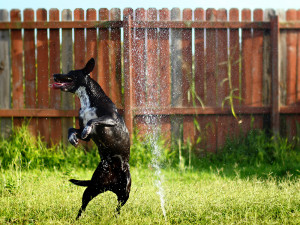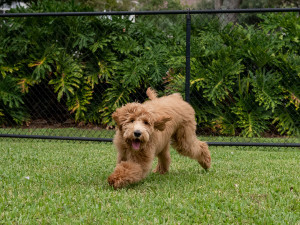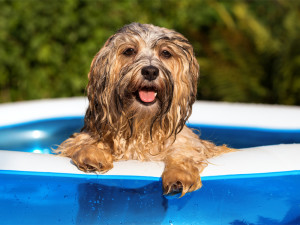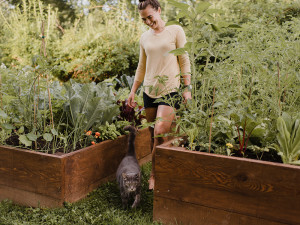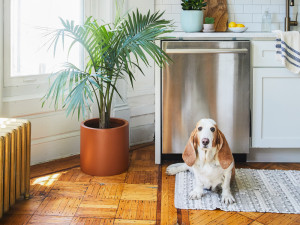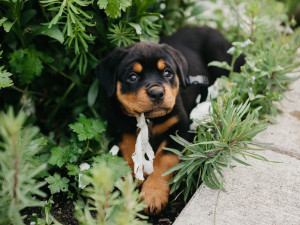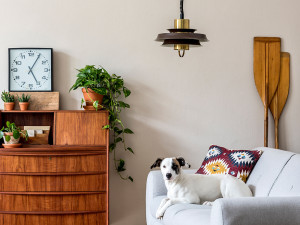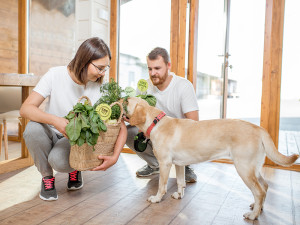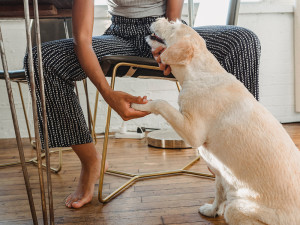Follow These 4 Pet-Safe Pest Control Tips for Your Summer Garden
You need to be extra careful if your dog or cat is your gardening assistant.

share article
Our houseplantsopens in a new tab might as well be on the list of things millennials and Zoomers treat as if they are our childrenopens in a new tab (plus, the upkeep cost is lower). For many of us, our collection of beloved plants also extends to our outdoor gardens. Considering the majority of us have to budget for a carton of eggs at the grocery store these days, it’s probably worth growing what we can for ourselves. Plus, there’s something about a summer garden that just makes these months that much better. If you’ve ever grown your own heirloom tomatoes, you get it.
Any gardener’s first instinct would be to reach for the pesticides at their local garden center, but hold that thought: A lot of pesticides can not only harm pets, but also the native wildlife. As you’ve probably come to realize by now, some pests actually do belong in your garden. To quote Mufasa, “Everything you see exists together in a delicate balance.”
Are pesticides bad for pets?
If you spray your garden down with pesticides, and your pets spend time in your yard, then they could be at risk of breathing in, ingesting, or absorbing the produce through their skin. One study linkedopens in a new tab a higher risk of canine malignant lymphoma to lawns treated with pesticides. Another revealedopens in a new tab that pyrethroids, a chemical used in many insecticides, can trigger seizuresopens in a new tab and even death.
Pesticides, including the organic kind, may also kill unintended targets, like the wildlife that live in your garden and help keep the local ecosystem in balance. Even the creatures that we think of as problematic pests — like aphids and other “sap-suckers,” snails, slugs, rodents, and hungry birds — play a role in maintaining a healthy environment.
“When we lose biodiversity within ecosystems, we lose the army of helpers that aid us in our gardens,” explains Elizabeth Waddingtonopens in a new tab, a writer, permaculture designer, and sustainability consultant. “We do not garden alone. From the pollinators that let fruits form, to the birds picking off pests, to the worms toiling below the soil — we need them all. Without them, and all the hidden helpers we never see, we simply cannot grow successfully.”
“The life below the ground is just as important as that above. It is important to remember that soil is far more than just ‘dirt,’” she adds. That being said, what you do plant in your garden opens in a new tabalso matters, and there are a variety of ways that you can contribute to the local ecosystem’s wellbeing through what you plant.
This includes forest gardens,opens in a new tab companion planting, rain gardens, ponds, reed beds, and incorporating native, pollinator-friendly plants. (Unfortunately, those pristine, green lawns that populate the suburbs are actually really bad for the planet.)opens in a new tab Thankfully, many natural pest-control methods that will help you strike the balance between growing a bountiful garden and protecting it from unwanted garden-munchers.
Natural, pet-friendly pest control methods for your garden
Think like a gardener.
Before using any of the methods below, first, you should look into the natural gardening methods, which have been used for centuries, that you can use to protect your garden from pests. These include:
Plant crops that attract predatory insects that eat pests, such as dill, cilantro, fava beans, and white clover.
Plant trap crops, such as sunflowers, to keep pests off other plants.
Rotate key crop families in your annual vegetable garden.
Use companion planting to make vegetables harder for pests to find (planting carrots with onions, for example).
“The key thing is not to eradicate pests entirely, but to manage your garden in such a way that the numbers of these pests are kept in control,” Waddington says. “Pest control in an organic garden means working with nature rather than fighting it. Remember, you need some pests to attract the things that eat them.” If pests are still a problem, then it might be time to introduce some pet-safe methods.
Use neem oil.
Neem oil comes from the seeds in the fruit of a shade tree called the Azadirachta indica, aka the neem tree. Its use as a medicinal herb in the Indian subcontinent goes backopens in a new tab thousands of years. (It’s also good for oral healthopens in a new tab, which explains why it’s in so many natural toothpastes.)
Organic gardeners swear by its use as an insecticide that helps repel mites, aphids, mealybugs, scale, whiteflies, and about 200 other plant-destroying insects. And, it doesn’t stick around in the soil: microbes break down azadirachtin, the compound in neem oil that helps control infestation, in between three to 44 days.
Thankfully, neem oil is safe to use around pets, birds, fish, bees, and other insects. To make a DIY spray, combine one quart of water, one teaspoon of neem oil, and a quarter of a teaspoon of castile soap. You should test a small patch of whatever plants you’re spraying and wait 24 hours, then check if the leaves have any damage. If there’s no damage, you’re good to go.
How to use it: When you have small, soft-bodied bugs like aphids and mites, shake the bottle to combine the ingredients, then spray down the top and bottom of your plants. Repeat as needed every seven days. Or, spray it down every 14 days as a preventative method. Do not use it on days where the temperature is high.
Or use Diatomaceous Earth.
If you’ve ever been a pet parent with a cockroach problem, then you should know Diatomaceous Earth opens in a new tab(DE). This pest-fighting, powdery white substance is essentially made from fossilized plankton. It wards off insects by sucking the oil out of their exoskeleton — this includes roaches, fleas, fungus gnats, and mites — and helps keep slugs and snails at bay. It won’t harm the soil or water, so rest your conscience. It’s also safe for humans and pets, as long as you get the “food grade” DE. It’s important to use it correctly; DE can irritate your and your pets’ lungs if it gets into them.
How to use it: To use DE, sprinkle it on the ground around your plants where you tend to find the offending bugs at night. You can also dust your plants, but this method can harm bees and other beneficial insects. To prevent that, cover your dusted garden with burlap for a day, then remove the cloth and rinse the plants down.
Castile soap is also a good option.
This multi-purpose soap is usually made from olive oil, though some modern store-bought varieties might also include coconut oil. Castile soap has a ton of DIY household uses that can help you replace store-bought products, such as all-purpose cleaners, body wash, and as a gentle insecticide. It’s effective against aphids, mealybugs, spider mites, whiteflies, and other insects while not being harmful to pets, ladybugs, butterflies, and wild birds.
How to use it: To make a castile soap spray for insects, mix one tablespoon of soap into a quart of warm distilled water. Pour the liquid into a spray bottle. Before using it in your garden, test it on a patch of each plant and wait a day to ensure that it does no harm. If your plant seems okay, then mist the mixture over your entire garden.
To sum it up, you should grow your own food—just naturally.
If you have the space and capacity for it, growing your own food partially reduces your reliance on produce that’s been shipped from potentially thousands of miles away. In fact, a recent studyopens in a new tab published in the journal Nature Food revealed that these “food miles” account for six percent of the world’s greenhouse gas emissions. (As if we needed more bad news about everyday things that are contributing to our planet’s overheating.)
Don’t have much space? Don’t worry — garden size doesn’t matter, but what you do with it does. According to a 2022 studyopens in a new tab published in the Journal of Applied Ecology, small urban gardens with native pollinator-friendly plants are just as important as the big ones when it comes to helping wildlife.
Plus, local produce also tastes better because you’re more likely to experience it at peak ripeness. Your pup will appreciate you sharing your harvest,opens in a new tab too.
References:
Azadirachta indica: A Herbal Panacea in Dentistry – An Updateopens in a new tab
Global Food-Miles Account for Nearly 20 Percent of Total Food-Systems Emissionsopens in a new tab

Kat L. Smith
Kat L. Smith is a writer and editor based in Queens, New York. They have written for LIVEKINDLY about a wide range of topics related to sustainability, lifestyle, house plant care, and food. They share their apartment with their adopted dog, Layla, and Vivi, a one-eared cat.
Related articles
![Rottweiler puppy chewing on a white flower in a garden]() opens in a new tab
opens in a new tabSnail Bait Poisoning in Dogs: Symptoms, Treatment, and Prevention
It may protect your plants, but at what cost? A veterinarian explains how this toxin may keep your garden safe — but it’s extremely toxic to dogs. Here’s everything you need to know.
![Dog sitting on a couch in a living room with plants]() opens in a new tab
opens in a new tab5 Plants That Are Toxic to Your Dog
Thriving plants are spring’s whole thing—but these offenders can be perilous to pets.
![Young couple feeding their dog with healthy green food from the farmers market at home]() opens in a new tab
opens in a new tab8 in-Season Fruits and Veggies That’ll Make a Healthy Treat for Your Dog
Use this as your spring farmers' market shopping list for you and your pub.
![Woman holding a beagle in warm dappled summer light]() opens in a new tab
opens in a new tabYou’ve Got a Summer-Lovin’ Pup. Here’s How to Keep Them Safe
Some like it hot (but not most dogs). Here are the season’s health hazards, from fleas to foxtails.
![A woman sitting in a chair holding a dogs paw in her hand and holding the dogs face in the other hand.]() opens in a new tab
opens in a new tab6 Natural Paw Balms That Will Keep Your Pup Safe From Summer Heat
The best paw balms, based on veterinarian recommendations.
![Shepherd dog playing with yellow ball at the beach]() opens in a new tab
opens in a new tabHow to Keep Your Dog Safe at the Beach This Summer
5 tips to help your pup have fun in the sun — safely.
